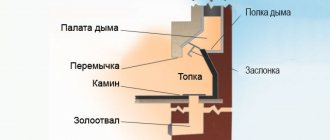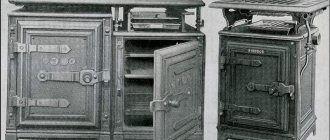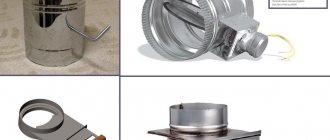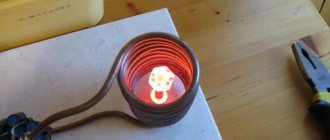How to make glass from sand
Most likely, you know that sand is needed to make glass, and indeed, it is the most important ingredient. To make a glass product transparent, quartz sand without metal impurities is used, which gives the material colored shades.
To make glass you will need siliceous sand, otherwise called quartz.
Since quartz sand has a melting point of 2300⁰C, components are needed that will help reduce it in order to make the manufacturing process easier and more affordable. Such an ingredient was sodium carbonate or ordinary soda ash, thanks to which the smelting temperature was reduced by almost half.
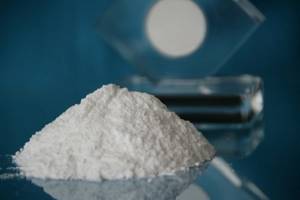
Baking soda (sodium carbonate) lowers the temperature required to produce glass sheets.
Soda makes glass water-permeable, which makes it impractical in everyday life and in production. To give the material strength, calcium oxide or lime is added to the alloy. Additionally, the composition may contain magnesium or aluminum oxides for maximum resistance to physical and chemical factors.
To produce thin decorative glass, such as crystal, lead oxide is used as an additive, which gives the products shine and fragility. Lanthanum oxide is commonly present in eyeglass lenses due to its ability to refract light rays.

The most commonly used additive in the production of decorative glass is lead oxide, which adds shine.
Sapphire glass for glasses is made with the addition of aluminum oxide, which makes it maximum hard and resistant to physical damage. To make colored glass, iron oxide is added to the alloy to produce red, nickel for brown and purple tints, copper and chromium for green, cobalt for blue and other metals.
In production, glass is made in several stages: first, the key components are melted together in a furnace to form a homogeneous alloy, then sent to a container made of tin, which does not mix with the glass, maintaining its homogeneity. Already at this stage, the glass gradually cools, becomes smooth and thin.

To obtain a homogeneous mass, it is necessary to remove the bubbles - to obtain this effect, glassmakers constantly stir until the molten glass mass thickens.
The alloy cools completely when moving along a conveyor, the length of which can reach 100 m; this is necessary to prevent the formation of excess pressure inside the alloy, which can lead to future defects. After the conveyor, the glass is further processed to create various products.
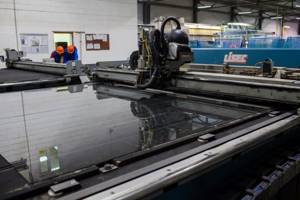
Glasses differ only in the constituent material used for manufacturing. But the process itself is almost the same.
How to choose?
Choosing a cast iron deck for your stove is not difficult. To buy a quality product, the installation of which will not require much effort, it is enough to take into account several nuances.
What are the sizes of cast iron sheets?
Cast iron sheets can be square or rectangular. The most popular are rectangular slabs. The surface dimensions directly depend on the size of the oven.
The standard dimensions of a cast iron stove for a stove are:
- 34 by 41 cm,
- 71 by 41 cm,
- 66 by 41 cm,
- 51 by 34 cm.
Number of burners in different models
Typically ovens have two burners. But their number can vary from one to six (it all depends on the surface area). Solid cast iron sheets may have no holes at all. But the cooking time on this type of stove can be long due to the slow heating of the cookware.
Other criteria for choosing a quality product
You should pay attention to the quality and composition of the material from which the stove is made. If you find chips, scratches and other various defects on the surface, then it is better to refuse the purchase.
A high-quality product has a smooth surface and its weight is quite large. There are no lightweight cast iron stoves.
It is worth taking the time to study the composition of cast iron. Cast iron, which is used for smelting, is a combination of 2% carbon with iron. But if it contains any components unknown to you, be sure to ask the seller about them. After all, some chemical elements are not environmentally friendly and can harm your health.
How to make glass at home with your own hands
To make glass at home, you will need a special furnace that provides heating to high temperatures. At home, they use a muffle, electric or pot stove, as well as a charcoal roaster.
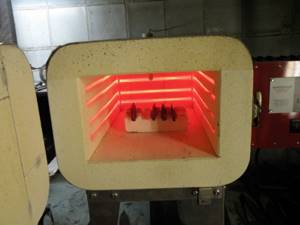
Special glasses can be melted in an electric, pot or muffle furnace.
The second option is simpler, but unsafe, since when heated to hypermaximum temperatures, the grill itself may melt. We will tell you how to cook glass in a special oven.
- Prepare a fireproof crucible (melting pot).
- Pour sand, soda and lime into the crucible, and impurities should occupy no more than 30% of the composition.
- Place the crucible in the oven and melt the composition at the highest possible temperature (1500-1700⁰C).
- Once the components are melted, pour the liquid alloy into the casting molds.
- The last stage is firing in a kiln cooled to 400-600⁰C. This will make the glass product hard and durable.
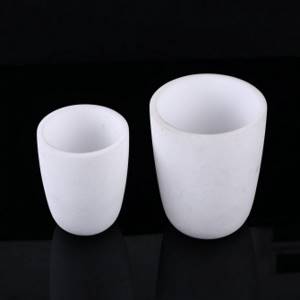
This is how you can prepare glass at home if you have special equipment.
Important! When working, follow safety precautions: use a welding mask, heat-resistant gloves, and do not go close to the furnace.
How to determine door dimensions
The initial stage of creating a door will be establishing the dimensions. This procedure is extremely important, since a product that has inappropriate parameters will interfere with the proper functioning of the device. As a result, installing a door that does not fit will become problematic. Algorithm of actions:
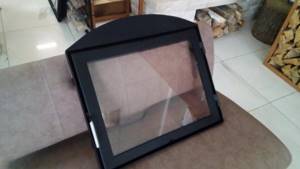
- To determine the dimensions of the stove doors, you will need a tape measure and a marker for notes, paper and a pen. You need to visually make approximately 3 marks along the length and width of the chamber and measure the distance. When the length results differ at the corners, it is necessary to record the smallest parameters with a deviation of no more than 1 mm.
- When the user wants to make a door for an arched stove on his own, he needs to measure the width and 2 heights: the largest and the smallest. Then the bend of the arch is determined. For rectangular and arched types, you should draw a sketch on paper in advance, optimally in the exact size. This will make it easier to transfer the required shape and measurements onto the door material.
Types of fireplace doors
Product classification depends on what material the doors are made of. There are several types with their own positive and negative qualities, features of operation and installation.
Glass doors for fireplace
A fireplace door with glass is an excellent solution that suits different interior styles. Fireplace heat-resistant glass is resistant to high temperatures and has increased strength. The thermal expansion of the material is insignificant - the coefficient is 30 times less when compared with ordinary glass. Due to their high heat transfer, they are able to withstand heating up to +1000 degrees Celsius, without cracking.
After 30 minutes of operation of the fireplace, the heating of the glass will be within +50-250 degrees Celsius. For hardened products, the temperature reaches up to +500 degrees.
Heat-resistant glass is made from special raw materials using special equipment, practically without the use of foreign impurities. The material is resistant to fire thanks to a special hardening technology; in addition, it is chemically treated and thermally polished.
Where is heat-resistant glass used?
Heat-resistant glass allows you to be close to fire without fear of flying sparks.
Fireplace
Heat-resistant glass for the fireplace keeps the fire open and increases safety of use.
Oven
Transparent oven and microwave doors allow you to maintain the temperature and monitor the cooking process.
Hob
Uniform distribution of heating of the hob.
Production
Fire-resistant glass in doors and partitions reduces the likelihood of a fire occurring and spreading.
Step-by-step instructions with photos for laying a stove
Different stove makers have their own masonry technologies and their own secrets that come with years of experience. Here is information about a fairly simple way to create a stove-fireplace for heating a two-story house; the process will not seem extremely difficult even to novice stove makers.
Foundation laying
The base course of brickwork will serve as the foundation. It is done with any brick; some stove makers even fill this level with crushed stone.
When laying the base row, cement mortar is used.
The foundation is completely filled with mortar, the layer is leveled.
Construction of the furnace body
The first row of stoves is marked. The horizontal line from which they start when marking is the wall of the room.
A grate is placed where the fireplace is planned to be placed. From this row, the bricks are already laid on the kiln mortar.
An important stage of work is the scrupulous alignment of each new row by level.
Laying the second row. The stove wall, located closest to the wall of the room, is reinforced with additional bricks to increase fire safety.
The place where the chimney will be located in the 2nd row remains empty, the rest of the stove is laid completely. A door is installed through which the owners will clean out the ash.
The door is installed on the solution and leveled. For a more reliable fixation, it is secured with wire, which must be laid between the bricks.
Next, the next 3 rows are placed. Then a brick stop for the grate is installed - 2 rows of 1/4 bricks are placed on the sides.

The grate is laid not on a simple brick, but on a refractory brick. To ensure that it lies at the same level as the bricks, holes are cut in the fireclay bricks.
The size of the brick can be easily adjusted - the excess is measured and carefully cut off.
The large door is mounted next to the installed grille.
Installing the oven door
Preparation includes the following necessary steps:
- Before installation itself, it is necessary to inspect in detail the door itself and the mounting frame (de facto, we take the fact that the door is already made to the required dimensions). Cracks and distortions of the door and frame are unacceptable; its plane must be flat and fit tightly not only in the area of the lock, but also over the entire area of contact with the frame;
- If an unsatisfactory condition is detected, the door is replaced or, if possible, the defects are eliminated;
- The door itself should move freely in the fastening elements. It should be easy to close and open;
- If the stove is made only for coal, then a hole of 13 mm is drilled in the door. in diameter. This hole will be an outlet for gases generated during the combustion of anthracite.
The door is exposed to the greatest impact during oven operation. It carries mechanical loads, as well as increased thermal loads. To ensure that the damper lasts as long as possible, the following instructions for each mounting option must be followed.
On nichrome wire
Nichrome has proven itself to be an excellent solution to this issue due to its increased resistance to heat and at the same time maintaining its ductility in the form of a wire. This mount is guaranteed to last 20 years. How to secure the door to a brick stove:
- The frame and door are a single hinged structure. A wire is attached to the frame and threaded through special holes. They are not difficult to make; it is enough to drill them with a diameter of no more than 5 mm.
- The wire is threaded through the holes, and the free ends are fixed in the masonry between the bricks.
Installing the combustion door on nichrome wire
The main disadvantage of this method is that the wire must be kept taut and gradually embedded into the seam between the bricks. The length of the wire is one and a half to two bricks. The whole process is very labor intensive.
On a stainless steel sheet structure
Installing the combustion door of a brick oven using this method is the most common. The frame is a structure that is identical to the door in geometric dimensions, but the frame plates have special collars. They are made from a corner, one side of which fits into the distance between the bricks, into the masonry. Next, everything is coated with the solution.
- In order to protect the brick from calcination from the metal corner, a layer of silicon thermal insulation is installed between them. This protects the masonry and seam from overheating and also softens the expansion of the metal when heated, which can harm the entire masonry.
- To best attach the slopes of the corners between the masonry, it is better to use self-tapping screws. Two holes are drilled coaxially in the corner and brick, and a self-tapping screw is screwed into them.
Installation diagramWhat does it look like in the oven?
The method of how to correctly install the door into the oven on a profile corner can be combined with the first one - on a wire, in which case the fastener will be both reliable and durable.
For self-tapping screws or bolts
This method has its place, but among stove makers it is the least common and reliable. The fact is that the design of the frame and door itself is very heavy, especially if it is made of cast iron. This method is applicable to the question of how to secure a door in a stove for the chimney, and not for the firebox.
- Holes are drilled from the front in the frame and brickwork;
- The frame is attached to an anchor at the location where the door is installed.
General installation diagramInstallation on anchors
Checking and finishing
The door and masonry should have a small buffer, since heating the frame in contact with the brick will lead to its bending, as well as damage to the screws - they can bend and come out of the screw-in point. In this case, the door will mutually move away from the masonry.
Making a glass oven door with your own hands
Metal is used as the basis for the fire door with glass . According to reviews from experienced stove makers, cast iron is preferable : it is durable, resistant to high temperatures, easy to clean, and durable. Stainless steel becomes very hot when the stove is fired , is not designed to withstand open fire and quickly warps.
Tools and materials
To work you will need:
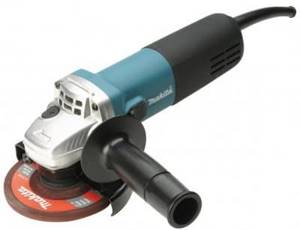
- Bulgarian;
- Metal sheet;
- heat-resistant glass;
- construction gloves;
- composition for masonry;
- welding machine;
- level;
- fiberglass.
When choosing panoramic glass, you need to remember its fire resistance.
Stages of work
The door installation work consists of the following steps:
- execution of a drawing of the entire structure;
- cutting metal blanks for frames and sash;
- frame manufacturing >;
- fitting the frame onto glass;
- canopy baiting;
- welding frame parts, installing glass element;
- installation of canopies, valves and handles.
Attention! The task is within the capabilities of those who have at least basic experience in working with a welding machine . If you have not done welding before, delegate this task to a professional.
Creating a blank
First, measure the size of the fireplace . A corner is cut according to the established parameters
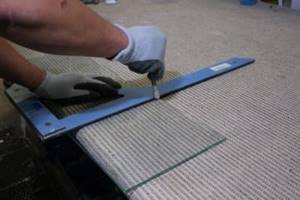
The frame is placed on a sheet of metal, the outline is marked . After checking all measurements, the workpiece is cut using a grinder or cutting wheel . This will be the lintel for the door.
The glass element is fastened with bolts screwed into the corner along the plane. They will prevent the window from falling out, but at the same time they do not interfere with thermal expansion.
The door is attached to the ceiling using awnings .
Attention! Before installation, the glass insert is removed from the frame!
The door angle is checked using a plumb line . To do this, use three-millimeter wire , previously burned and softened in the fire. It is inserted into the hole of the frame, folded in half and twisted tightly so that rings do not form at the ends. If you cannot do without them, the wire is flattened with a hammer.
A completely blind door, without a window, is less common. It is made according to the same principle, but without a transparent element. When the frame is ready, mark and cut out the future sash, making sure that it overlaps the hole .
Attachment to base
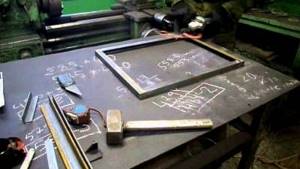
You can’t just attach a frame with a door to a brick. will be required . First, the contours are marked on the masonry, then a recess is cut out with a diamond wheel.
Most often, metal anchors are used for fastening. Before attaching the door to the base, check that it opens easily. If this is possible with visible effort, the workpiece needs to be modified.
The lintel frame is wrapped with asbestos cord , then coated with heat-resistant glue. The cord will have to be pushed into the recess around the perimeter with a screwdriver.
Reference! A free flow of air into the firebox is necessary. The preferred design is one with an oxygen supply regulator.
Before directly installing the door on the masonry, the base is painted with fire-resistant paint. When working, a respirator and goggles are required, as the composition is toxic and easily gets into the eyes and respiratory tract. The paint is applied in several layers to mask welding flaws.
Material
Metal (often stainless steel or cast iron) is used as the basis for the fire door for a stove with glass. According to the characteristics of experienced craftsmen, cast iron is more preferable: it is distinguished by durability, it is not afraid of high temperatures, it is easy to clean, and it is quite durable. Stainless steel will become very hot when the stove is fired; it is not intended for open fire and will soon warp.
From glass
Glass doors are available in single or double door versions. One oven door usually has a large window to view the fire. There is no difference in functionality. A lot depends on taste here. In two-door ovens, the design is close to ancient forms. It is possible to look at the fire through 1 large glass or 2 small ones. Much will depend on the preferences of buyers and the interior of the room. Advantages of a stove door with glass:
- Glass can withstand the influence of elevated temperatures for a long period of time - this positively distinguishes it from devices made of steel. It is superior in fire resistance to cast iron.
- Fireproof special glass for stoves and fireplaces is approximately 0.4 cm thick and can withstand temperatures up to 2000 degrees.
- Compact dimensions and low weight.
- The main advantage of a glass oven door is the ability to look at the flame. Such an option will outweigh any disadvantages, forcing stove users to purchase stove doors made of a similar material, despite the short period of use and high price compared to solid metal doors.
We recommend: Box for heating pipes: types (grids, baseboards), making a decorative niche from plasterboard with your own hands
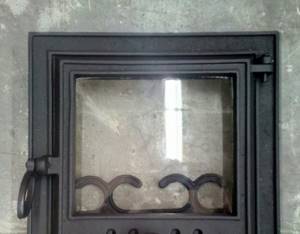
Flaws:
- The creation of glass doors for a furnace is considered to be a more labor-intensive process than production from a solid sheet. To avoid cracks during use, a little space is left when installing with a seal. The doors will trap sparks from the fire, preventing them from entering the room. Glass inserts are designed so that air blows over the material, preventing soot from lingering on it. Otherwise, the glass will be smoked.
- Fragility of the material. Fire-resistant glass sometimes cracks with minor impacts.
- The price of a device with glass inserts is higher than one made of solid material.
- Glass door ovens are much less efficient than cast iron ovens because heat dissipates through the glass. The larger the material, the less efficient the stove is at heating the room.
Important! Often a stove door with glass is combined with a metal device. In such situations, the frame is made of steel and the door is made of glass.
Advantages and disadvantages
Good quality panoramic glass allows you to see what is happening inside the firebox without getting hot. This door is absolutely safe . The door is fireproof . Unlike stainless steel, panoramic glass does not deform from high temperatures . For many homeowners, cast iron or iron elements in the interior seem rough. This cannot be said about panoramic glass, which harmonizes with any decoration .
Of course, such a door also has disadvantages . The first of these is fragility . If you accidentally hit a stainless steel door with a poker, it will not affect it in any way, but the glass will crumble. In addition, after each kindling it is necessary to remove soot , otherwise the glass quickly ceases to be aesthetic and transparent and takes on a sloppy appearance.

Photo 1. “HG” cleaner for heat-resistant glass, 500 ml, suitable for removing soot and soot from a glass door.
Heat-resistant glass is capricious; detergents with an abrasive composition are not suitable , as this will easily damage the polished surface of the screen.
Solid metal door
This category involves doors made entirely of metal. The installation process is quite simple and does not have any complications. The products retain heat well and are distinguished by increased fire safety. When the need arises, it is possible to make them yourself with minimal expense. Key advantages of metal products:

- Reasonable price. Compared to a stage on a glass device, it is much smaller, which is why it has a certain prevalence.
- Durability and reliability of such devices. With proper care (regular anti-corrosion treatment using paints that are classified as fire-resistant), they will last a long period of time without causing discomfort to the user.
Important! Despite the fact that such doors have their own consumer, the market demand is quite low, since they do not provide the opportunity to look into the flame.
Cast iron door
Cast iron doors, which are heat resistant, are considered the best for brick stoves. When parts made of steel deform over time due to temperature, those made of cast iron can last for decades. In the place of combustion, the temperature will reach 800 degrees, and for steel the working temperature will be 600. Therefore, a high-quality oven door is cast iron. The technology for making cast iron requires a foundry, so it cannot be obtained in a small business environment.
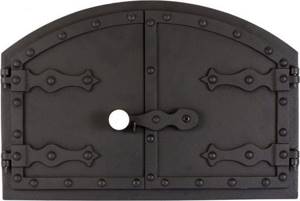
Main advantages:
- Excellent interaction with elevated temperatures.
- Durability and reliability. The cast iron fireplace vent door can withstand any load.
- Beautiful models can be easily created from cast iron.
All this optimally finds its own application in this area; many firebox doors are made directly from cast iron.
Criterias of choice
The basic rule when choosing glass for a fireplace door is the very purpose of the heating structure. If it is planned to be used as a heating source, then it is recommended to choose laminated glass, since this is the material that can withstand high temperatures. For a fireplace that primarily performs decorative functions, one layer of glass will be sufficient.
In addition, when choosing glass you should take into account a number of other features:
- the glass must withstand the maximum temperature that will be created inside the firebox;
- the maximum service life should be selected;
- the glass should muffle the noise created inside the firebox;
- the material must be sufficiently reliable.
Decor and other functions of the fireplace door
Against the backdrop of the disadvantages of an open firebox, a fireplace door is simply a wonderful salvation from all of the listed disadvantages. Even though the flame is hidden behind the glass door of the firebox, you can still admire it through the clear glass. Everyone knows about the decorative functions of closed fireboxes, so let’s immediately move on to technical issues.
Good to know: How to make a fireplace in a gazebo, practice of building a gazebo and fireplace
A closed firebox allows you to install a water circuit in the fireplace, and these are prerequisites for the full use of the fireplace as a heat-producing device, and the main one.
Thanks to the special door design, it is possible to use slow burning technology. By regulating the air supply, we achieve better fuel combustion and, therefore, an increase in efficiency. By installing protection, you can be calm about safety, even if children are playing in the room.

Classic fireplace design
Pros and cons of glass for fireboxes
As everyone already knows, a fireplace with glass doors allows you to safely admire the fire. Such doors are often used for decoration purposes and in heating devices that only imitate the combustion process. Through a slightly shaded, but fairly transparent screen, the artificial flame looks quite beautiful.
In addition, the fireplace door with glass will not allow small children and animals to get inside the firebox. With its help, an excellent view of the home opens up, protection from soot blowing out during drafts is created, and thermal energy is prevented from escaping from the room. Glass makes the fireplace visually lighter, but the door will require constant maintenance.
Soot can be removed easily and easily from smooth door surfaces. Just rinse the glass with water and it will begin to shine. In addition, glass material is considered hygienic.
It is possible to order glass for fireplace doors according to individual sizes. In such cases, you can give free rein to your own imagination in creating a design.
In addition, the fire is always protected from the possibility of spreading throughout the room; the combustion process in a closed firebox is easier to regulate.
A door with glass helps release more energy, withstands various overloads well, and can be easily repaired if necessary.
In addition to the positive aspects, there are also certain disadvantages:
- a rather large specific gravity, which is why designers have to develop special mechanical devices to open the door, which entails an increase in the cost of the entire structure;
- over time, soot begins to appear on the surface of the glass, which is the main problem today;
- the high cost of glass for a fireplace is another significant disadvantage.
Why do they even put doors on the fireplace?
It is believed that a glass door is a necessity for a modern fireplace. Everyone sees something different in this. The advantages of a fireplace door seem to be undisputed. So why?
- Safety.
With a fireplace door, you don't have to be afraid to step away from the fireplace. After all, at any moment a coal can jump out and burn through the flooring. Children may get burned. Smoke may come out, after all... There is an opinion that in general “there are no fireplaces that don’t smoke”... and so on.
- Energy efficiency.
A fireplace door prevents the biggest disadvantage of open fireplaces. They keep you warm while they burn. But as soon as active combustion ends. All the heat is “blown out” quite quickly into the pipe. A very large volume of air is “pumped” through an open fireplace, which does not allow it to be used as a full-fledged heating device.
With the installation of the door this problem goes away. At any time, you can cover/close the ash pit and the coals will burn out without sacrificing all the heat that the burning wood provided.
- Aesthetics.
It is generally accepted that a fireplace door with glass prevents possible smoke in the fireplace. The fireplace spits less when there are pressure changes and problems with the flow of combustion air. Dark marks of soot do not appear on the arch/covering of the fireplace.
Large fireplace door, fresh from the workshop.
Types of glass door designs
So, we figured out which glass you can choose for your fireplace. It remains to clarify the existing design options.
The door itself consists of a frame made of cast iron or steel material into which fire-resistant glass is inserted. From the outside, handles and locking devices made of materials that cannot be heated or wrapped with heat insulators are hung on the doors.
Frames can be tinted or painted with fire-resistant paints. Note that the percentage of glass to metal can vary within a free range.
According to the options for attaching hinged overhangs to portals, products can be divided into the following types:
- with a vertical arrangement - used for hinged or folding doors;
- with horizontal placement - made according to the principle of an opening window transom.
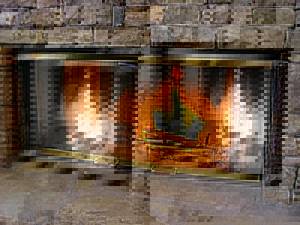
Also, a fireplace door with glass can, like a guillotine, be lowered and raised, or moved to the sides (the latter option is rare).
Products can be grouped according to certain characteristics, which include:
- total number of sections;
- type of closing and opening doors.
Self-production of forged doors
Real forging is very expensive, so you can use its imitation. But since the structure will not be so strong, it should be created on the basis of a frame. For this, two corners are used. The frame will not be solid, but only representing the lower part of the door and the part to which the hinges will be attached.
Forged doors are usually made as double hinged doors. Forging elements are welded onto the created frame. The main thing is that they are identical in pairs on two doors. Such fireplace doors will not stop flying embers, and this should be constantly remembered.
The difference between heat-resistant glass for a fireplace and ordinary glass
If we compare the main differences between ordinary glass and heat-resistant glass for fireplaces, ordinary glass, when in contact with an open fire, will heat up to a temperature of over 500 degrees in half an hour. While heat-resistant glass for a fireplace during the same time will have a temperature from 50 to 250 degrees, depending on the type of glass and its manufacturing technology.
However, technology does not stand still, and today heat-resistant glass for a fireplace is not just heat-resistant glass, but heat-resistant glass ceramics, transparent with low temperature expansion.
Should I put a door on the fireplace? Benefits of an open fireplace.
To be specific, an open fireplace is a very practical thing. Whether it is a house with or without stove heating. Yes, let’s say right away that stove heating does not exclude the presence of an additional fireplace. It perfectly complements life in a house with stove heating. With a fireplace, it is much easier to choose the furnace firing mode for heating the house; we’ll talk about this in more detail later.
A familiar picture: a family gathers and two or three generations are sitting in front of their smartphones... believe me, a fireplace can turn the familiar picture around a little. It acts as a gathering place. He participates in life - as a reason for his brothers, as a small holiday. A little fireworks, if you want analogies. Living fire carries something magical... Be that as it may, it fascinates and encourages communication. Distracts attention from the smartphone. Living fire in our lives is something unusual, oddly enough.
You can even hold business meetings, not just family ones, behind an open fireplace. It would seem, why install a fireplace door with glass?
The nuances of caring for fireplace glass
If you have installed a fireplace or stove with a glass door, then you are most likely familiar with the problems of how to clean soot from glass.
Quite often, the fireplace is considered the center of attention in the house, and it should always look neat. To do this, you will have to take into account some of the nuances associated with caring for it.
The process is simplified if the door has an automatic glass cleaning system. In this case, you will not have to wash it often, but it is still not recommended to forget about water procedures.
You shouldn’t put off cleaning until later; it’s better to do everything in a timely manner to save time and effort. The right solution is to periodically wipe the glass with a special compound.

Fireplace glass needs to be cleaned regularly.
The correct fuel must be used to fire the fireplace. Coniferous varieties produce the most soot due to the high level of resin content. In addition, the firewood must be thoroughly dried before use to minimize the percentage of soot generated.
To clean the glass surface, you must use liquid compositions or solutions with the addition of ammonia, prepared independently.
By following these simple rules, you can keep your fireplace glass clean at the highest level.
Self-installation
Considering the specifics of stove work, a specialist is usually invited to do this, who not only lays the stove, but also installs the doors. To save money, you can do the installation yourself.
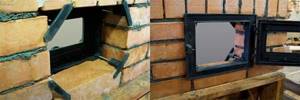
Reliable fastening is carried out in several ways:
- using nichrome wire;
- metal strips (clasps);
- self-tapping screws installed in the side crossbars.
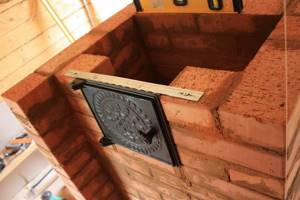
Metal pieces of sheets are fixed to the brickwork with anchors or bolts.
The disadvantage of the first method is that the wire must be tensioned all the time, gradually being laid between the bricks. It is put into the seam; the length is chosen to be approximately 1.5–2 brick lengths.
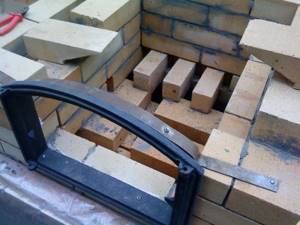
Most often, metal plates forming a frame are used for installation. Simply, this is a corner, one side of which is embedded in the oven, and the other is attached to the door. It is imperative to place thermal insulation between the metal and the brick (ceramic cord is used). For reliable fastening, use self-tapping screws screwed into pre-prepared holes in the brick and corners.
The third method of installing the door is used least often. It is generally not suitable for cast iron doors, since it will not guarantee reliable retention. Chimney doors are more often installed using bolts than firebox doors.
If everything is done efficiently, the laying was done by a professional, the installation was carried out correctly, the stove will warm the room well and bring pleasure to the residents.

